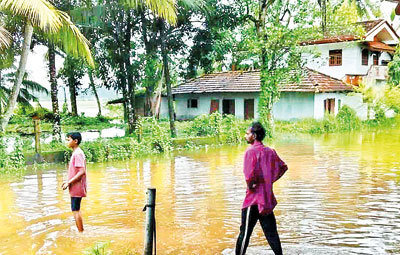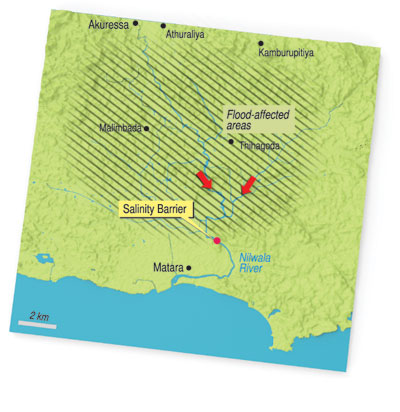News
Marooned in their homes by flood waters, Matara residents point fingers at the salinity barrier
View(s):By Dilushi Wijesinghe
Stranded in one’s home for over a month, submerged in nearly 2 ½ feet of water– this has been the fate of many people residing in Matara.
Wattage Chandana, a resident of Kamburupitiya owns a rice mill and is the father of two. He and his family have been stranded in their home since the beginning of September.
Initially, he says, they had been supplied with dry rations.

The waters still surrounding Chandana's home and below, ruined furniture inside the house
The only modes of transport are the boats and rafts provided by the Army. But residents are fearful of venturing out after a saltwater crocodile was spotted in the area.
Chandana’s elder son was sent to a boarding in Galle as he was unable to attend school for a few days. He is to sit for the G.C.E. Advanced Level Examination this year. Like his son, many children have faced a disruption in their education due to the flood situation.
The government provided transport for children who sat for the scholarship examination on October 15.
Although floods are a common occurrence in Matara, this time they have been unprecedented, with large areas on either side of the Nilwala River being severely affected.
The Nilwala River, which is 72 km long, flows from the Sinharaja Forest Reserve and falls into the sea in Matara.
A salinity barrier that was built by the Lanka Hydraulic Institute in 2017 to prevent saltwater mixing with freshwater is believed to be the main reason for the excessive flooding.
The farming community and experts had voiced concerns that the salinity barrier could impact the severity of floods in the area.
On January 14, 2016, the Central Engineering Consultancy Bureau sent a letter dated January 14, 2016 to the National Water Supply and Drainage Board predicting future floods in this area and a possible alternative.
Today, many are facing the reality of that prediction.
“About 3/4th of people have been affected in the southern province, just like me, a majority residing in this area are from the farming community. Today, there is not a single grain of paddy to be seen,” Chandana said, emphasising the devastation caused to paddyland.
Farmers charge that the government’s aim is to provide water to the 500,000 odd people who depend on the Nilwala River rather than looking into the welfare of the farmers.
The barrier is one of four bridges constructed within six kilometres of the latter part of the Nilwala River.
The authorities announced that the salinity barrier would be removed on October 20. However, Matara District Secretary Y. Wickramasiri told the Sunday Times that only 40 feet of sheet pile will be removed.
The barrier consists of five gates, which are 30 feet wide each, adding up to a width of 150 feet.
Researchers have suggested a short-term alternative: digging a bypass canal to allow the floodwater to recede within 2–3 days. Farmers, however, say that officials will probably not do so as it will appear to be a failure on their part.
Met Department statistics show that although there was higher rainfall prior to the barrier being built in 2017, the impact and aftermath of the floods were much less compared to recent years.
The Sunday Times learns that the salinity barrier cost about Rs. 3000 million. Meanwhile, crop damage caused by flooding in Matara every year is estimated to be around Rs. 5000 million.
| Highlights from the CECB letter in 2016 The Central Engineering Consultancy Bureau letter dated January 14, 2016 to the National Water Supply and Drainage Board carried the following: 1. Installation of the barrier will elevate the impact caused by future floods as the cross-sectional area (area = width x depth) is reduced. | |
The best way to say that you found the home of your dreams is by finding it on Hitad.lk. We have listings for apartments for sale or rent in Sri Lanka, no matter what locale you're looking for! Whether you live in Colombo, Galle, Kandy, Matara, Jaffna and more - we've got them all!

